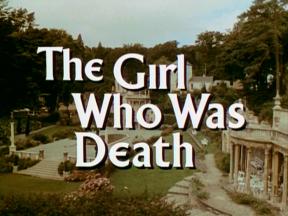 The Girl Who Was Death
The Girl Who Was DeathTransmission Date: 19/1/1968
Episode Length: 48'49m (DVD timing)/50'37m (Blu-Ray timing)
Est. Ratings: 8.9m
Written by: Terence Feely from an idea by David Tomblin
Directed by: David Tomblin
DVD availability: Try amazon.com
Production Commenced:
1967
Production Credits:
An ITC Production by Everyman Films Ltd. Producer: David Tomblin; Production Manager: Ronald Liles; Director of Photography: Brendan J. Stafford B.S.C.; Art Director: Jack Shampan; Camera Operator: Len Harris; Editor: Eric Boyd-Perkins; Theme: Ron Grainer; Musical Director: Albert Elms; Assistant Director: Gino Marotta; Sound Editor: Will Thompson; Sound Recordist: Cyril Swern; Music Editor: Eric Mival; Casting Director: Rose Tobias-Shaw; Set Dresser: John Lageu; Continuity: Phyllis Townshend; Make-Up: Frank Turner; Hairdressing: Olive Mills and Wardrobe: Dora Lloyd. Made on location and at Metro-Goldwyn-Mayer Studios, Borehamwood, England.
Starring:
Patrick McGoohan (The Prisoner); Kenneth Griffith (Schnipps); Justine Lord (Sonia); Christopher Benjamin (Potter); Michael Brennan (Killer Karminski); Harold Berens (Boxing M.C.); Sheena Marsh (Barmaid); Max Faulkner (Scots Napoleon); John Rees (Welsh Napoleon); Joe Gladwin (Yorkshire Napoleon); John Drake (Bowler); Gaynor Steward (Little Girl); Graham Steward (First Little Boy); Stephen Howe (Second Little Boy); Phyllis Bundy (Pretty Spectator, uncredited); Jimmy Millar (Irish Napoleon, uncredited); Alexis Kanner (Photographer/voice of The Chief, uncredited) and Robert Rietty (Voice of No.2 in titles, uncredited)
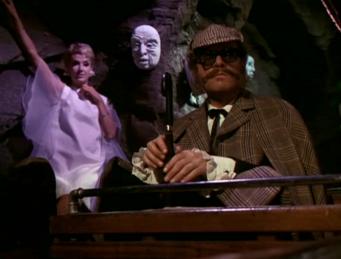
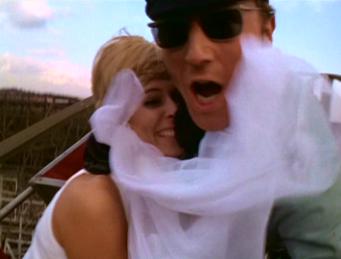
Episode Order:
While I've talked about the need to place dream sequences/same actors in context during this new episode order, there's no getting away from the fact that not only does the photographer of No.6's story bear a remarkable resemblance to No. 48 from the final episode (and also The Kid from the preceding one) but No.6 appears to imagine the exact design and sounds of the rocket from Fall Out. Well, I guess when you consider who No.1 is...
Is No.6 John Drake?:
Christopher Benjamin plays "Potter" in this story, a role he also played in Danger Man. As if to confound the fans further, a cricketer is famously played by an actor named John Drake.
Storyline:
Professor Schnipps, a mad scientist, has spent six years working on a rocket to destroy London. After a spy, Colonel Hawke-Englishe, assigned to locating Schnipps' rocket, is killed, another spy is placed on the case. He is given his instructions at the Magnum Record Shop, booth seven, where he learns he must tail the Professor's daughter, Sonia. From the cricket ground he follows her to his local pub (barmaid Doris), where she poisons him. From there she leads him through the steam baths, Barney's boxing booth, the fairground and the tunnel of love. She constantly eludes the spy until he chases her by car to the town of Witchwood.
Here he undergoes a series of traps through three shops; Leonard Snuffit, candlestick maker; David Dough, baker and Brendan Bull, butcher. After believing she's killed him, she makes her getaway by helicopter - with the spy in tow. He tracks her down a secret cave system that leads to a lighthouse. The lighthouse, it transpires, is the rocket. There her father (her mother apparently died in a "cavalry charge") is dressed as Napoleon, with a half-dozen troops dressed the same. His troops are all representative of regions, including a Scottish Marshall, Welsh Marshall Jones and Irish Marshall O'Rourke. They capture the spy and tie him to a chair, to be detonated with the rocket...
Escape:
Freeing himself from the chair, the spy rigs the controls of the rocket to explode, and reverses the charges in the armoury. Schnipps, his daughter and all the marshalls kill themselves, and the lighthouse rocket explodes.
The view then changes, and we see that the spy has been No.6 all along, telling a story to three children in the Village nursery. No.2, who looks exactly like Schnipps, and his assistant, who is the image of Sonia, remark that No.6 has given nothing away in their quest to find out information.
Trivia:
Originally intended as a two-part episode or possible 90 minute special, The Girl Who Was Death was trimmed down into the standard 50-minute slot. Whole scenes, such as a machine-gun chase in a maze, were consequently never made. McGoohan was still away filming Ice Station Zebra at this point, so his linking shots were filmed against a film backdrop much later. This use of doubles and backdrops is often quite obvious, particularly during the fairground scenes. Plans for Griffith to dress as Hitler in the fictional scenes were dropped at McGoohan's request on the grounds of good taste.
From this point on episodes of The Prisoner were screened later than usual on ATV. While episodes were originally broadcast at 7:30pm, the final three aired five minutes later.
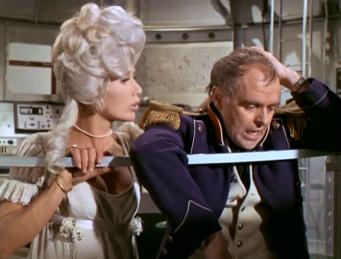
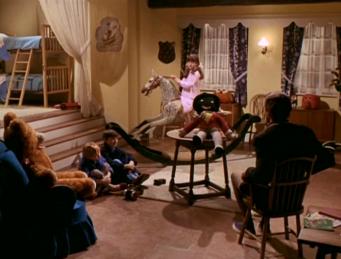
"It was so damned unsporting."
"It certainly wasn't cricket."
Viewpoint:
On a personal note, this was the first Prisoner episode I saw in its entirety, back when I was around eleven. (This was one of later repeat broadcasts, incidentally, I�m not that old). As a child it kept me captivated throughout, a good sign, though its demands on an adult audience are fewer.
As discussed in the review of Arrival, The Prisoner can be many things. What it can�t be, perhaps, is funny. Patrick McGoohan�s a fine actor, but when manic intensity is your forte it fails to translate into old fashioned belly laughs. While undeniably stylish, this is probably one of the most dispensable episodes of the lot, a throwaway before the big finale.
As the most literal exponent of No.6�s survival instinct, the episode never fails to engage, and the ingeneous scenes where he escapes death in various death shops are inspired. However, your take on it possibly depends on how much you like self aware television. Are the appalling film backdrops there as a postmodern take on The Avengers and other ITC fare� or had they just run out of money? After sitting through It�s Your Funeral/A Change of Mind I�m not certain it�s not the latter. Okay, Pat was away filming Ice Station Zebra for the fairground location shoots, but it mars the episode to have Alexis Kanner daring to stand upright on a moving rollercoaster� only to cut to shots of McGoohan in front of a backdrop.
Entertaining yet somehow irrelevant, the episode does seem to drag a little in pacing towards the end these days. One signifier of how old this programme actually is comes with the antiquated appearance of a Golliwog doll in the Village nursery. Attributed as the creation of Florence Upton in 1895, the popularity of the creature was further heightened by Enid Blyton in the 1940s and 1960s. Blyton�s books � most particularly 1944�s The Three Golliwogs � were extremely racially insensitive (though were not seen as such at the time), and by the 1980s calls to ban the doll and its representation in other mediums � most notably as the mascot to a famous jam manufacturer � were in full force. Adding to this slightly unsettling sight is the concept of children in the Village, an idea not touched upon in any great depth as this is, of course, the throwaway comedy episode.


